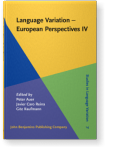Where is syntactic variation?
This paper discusses the consequences of some major recent developments in syntactic variation research: (i) the shift from a macro-comparative to a micro-comparative approach; (ii) the use of dialectological, sociolinguistic and theoretical methods to collect dialect syntax data; (iii) the rapidly increasing on-line availability of large amounts of data on large amounts of dialects; (iv) the hypothesis in minimalist generative grammar that there is no cross-linguistic variation in the syntactic module of the mental grammar and that all syntactic variation is reducible to other linguistic and non-linguistic levels. A brief overview is provided of the micro-comparative syntactic research infrastructure that has been built up in recent years. To demonstrate the usability of the available data and the minimalist hypothesis, the paper concentrates on the highly pervasive but little studied phenomenon of syntactic doubling. It is argued that syntactic doubling is necessary to express semantic relations and that there is much hidden doubling because locally recoverable doubles can and in certain cases must be left silent at the level of phonological spell out. In this way, syntactic doubling is an important source of syntactic variation. Using a model of linguistic variation that includes syntax, other levels of the mental grammar (phonology, semantics, pragmatics), cognition (e.g. memory, thinking), body (e.g. oral tract) and society, the paper then shows which piece of syntactic variation can be reduced to which level of linguistic variation model, thus answering the question of the title.
Cited by (2)
Cited by two other publications
Lekakou, Marika
2017.
Article Doubling. In
The Wiley Blackwell Companion to Syntax, Second Edition,
► pp. 1 ff.

This list is based on CrossRef data as of 20 july 2024. Please note that it may not be complete. Sources presented here have been supplied by the respective publishers.
Any errors therein should be reported to them.
